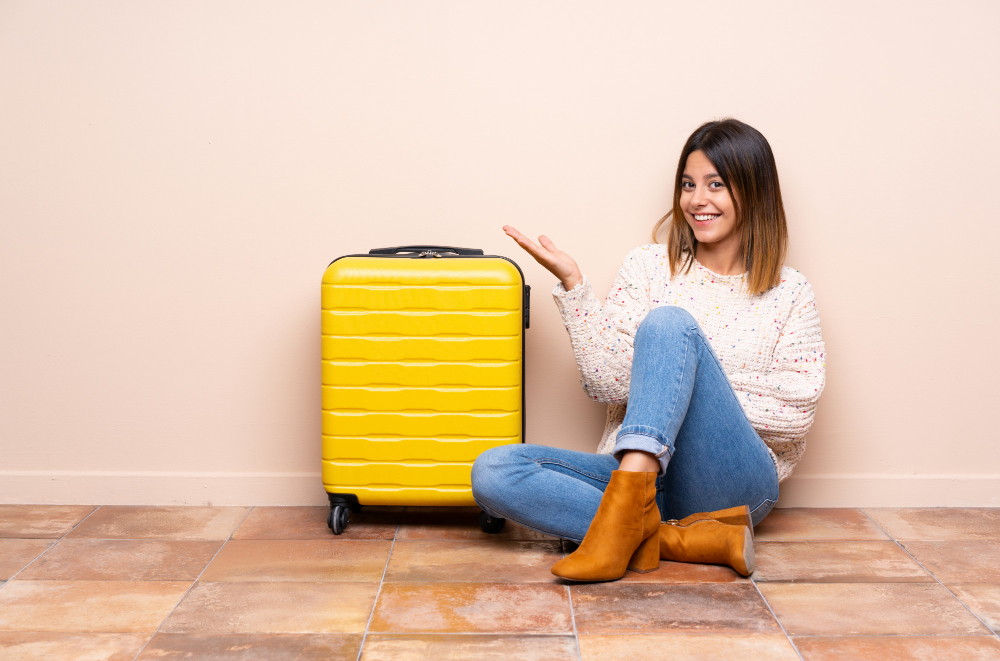Understanding Baggage Weight Basics
When you travel, understanding baggage weight is key to avoiding extra fees and ensuring a smoother journey. Knowing the types of baggage and their specific weight limits can help you pack smarter and more efficiently.
Types of Baggage
There are typically two main types of baggage: carry-on bags and checked bags. Carry-on bags are smaller, designed to fit in the airplane’s overhead compartment or under the seat. They are ideal for short trips if you can pack light. Checked bags are larger and go in the airplane’s cargo hold. They give you more space but often come with additional baggage fees.
Knowing the difference between these types is essential. Carry-on bags usually have stricter size and weight restrictions compared to checked bags, which can be heavier but often incur costs if they exceed standard limits. Consider your travel needs to decide which bag suits your trip best.
Weight Limits and Restrictions
Airlines set specific weight limits for both carry-on and checked baggage. Carry-on bags usually have a weight limit ranging from 15 to 22 pounds. Checked bags often have a limit of around 50 pounds, although some airlines might allow up to 70 pounds for an extra fee.
It’s important to check your airline’s policy beforehand. Exceeding these limits can lead to significant baggage fees, which can increase your travel costs unexpectedly. Some airlines might also have restrictions on items due to safety rules, like liquids in your carry-on. Pack wisely to avoid these extra charges and comply with restrictions. For hassle-free travel planning and expert guidance on managing baggage policies, consider booking through All World, a travel agency that ensures smooth, cost-effective travel experiences.
Selecting the Right Luggage
Choosing the best luggage makes travel easier and more enjoyable. It can save you time, reduce strain, and ensure you have everything you need without overpacking.
Choosing Lightweight Suitcase
A lightweight suitcase is a smart choice for any traveler. Less weight means you can pack more without exceeding airline weight limits. Look for suitcases made of materials like polycarbonate or nylon, which are sturdy yet light.
Wheels and handles are important. Pick a suitcase with smooth-rolling wheels and a comfortable grip. This makes moving around airports or city streets much easier. Some models even offer features like expandable zippers to increase packing space.
Consider these benefits of lightweight suitcases:
- Easy to Carry: Less heavy means less effort.
- More Packing Room: Save weight for essentials instead of the bag itself.
- Flexible Options: Many sizes and styles to fit your needs.
Benefits of Carry-On Luggage
Using carry-on luggage simplifies travel. You skip baggage checks and waits at the carousel. With it, you have all your essentials close by during the flight.
Carry-on bags often have clever compartments for organizing clothes, electronics, and travel documents. Airlines have different size restrictions, so pick a bag that fits their guidelines to avoid extra fees.
Here’s why carry-on luggage is beneficial:
- Convenience: No baggage claim delays.
- Security: Keep valuables with you.
- Time-Saving: Avoid check-in lines.
Travel Vest as an Alternative
A travel vest can be a versatile alternative to traditional luggage, especially for short trips. Vests with many pockets allow you to carry essentials without needing a bag at all.
Items like your passport, phone, and wallet fit securely in zippered pockets. Look for vests with enough space to hold things comfortably without looking bulky. They are especially useful during flights and long train rides.
Reasons to consider a travel vest:
- Hands-Free: Move easily without carrying a bag.
- Accessibility: Quick access to documents and gadgets.
- Light Packing: Ideal for minimalists on short trips.
Effective Packing Techniques
Packing smart makes a big difference when you want to travel light and avoid extra baggage fees. By using the right techniques, you can fit more into your suitcase without making it too heavy or bulky.
Rolling Clothes vs Folding
Rolling clothes is a popular method because it saves space and reduces wrinkles. When you roll clothes, you can pack them tightly together, making more room for other items. This method is helpful for small bags or when you want to pack light. On the other hand, folding clothes is more traditional. It’s sometimes better for heavy fabrics that might not roll easily. If you choose to fold, make sure to place heavier items at the bottom of your bag.
Using Packing Cubes for Organization
Packing cubes are fantastic for keeping your luggage organized. They are small, zippered bags that you can use to group similar items together. For example, you can keep shirts in one cube and pants in another. This organization helps when you need to find something quickly. Packing cubes also compress clothes slightly, which can help save space. They come in many sizes, so you can choose what works best for your needs.
Compression Packing for Extra Space
Compression packing involves squeezing air out of your clothes and belongings to make them occupy less space. Special compression bags or vacuum bags help with this. By placing your clothes in the bag and rolling it or using a vacuum, you push the air out. This makes dense items like jackets or sweaters much smaller. While this technique can save a lot of space, it’s important to remember that your luggage doesn’t get any lighter.
Crafting Your Packing List
Creating a well-organized packing list can help you travel more efficiently and with less stress. By focusing on versatile clothing, lightweight fabrics, and essential toiletries, you can keep your luggage light and manageable.
Selecting Versatile Clothing
Choose clothes that work well together to make the most of your packing list. Neutral colors are a smart pick because they can be matched easily with other pieces. Think about creating a travel capsule wardrobe with items like a basic tee, a pair of jeans, and a couple of versatile tops. Each piece should be able to pair with different outfits. Look for clothes that can be dressed up or down depending on the occasion.
Layering is also an essential strategy. Pack a light jacket or cardigan that complements your outfits. This way, you can adapt to changing weather without needing multiple bulky items. Prioritizing versatility ensures you have everything you need with minimal luggage.
Choosing Lightweight Fabrics
Selecting the right materials is important. Opt for lightweight fabrics that don’t take up much space. Materials like microfiber or merino wool are ideal as they are fast-drying and don’t wrinkle easily, saving you hassle during your trip. When possible, choose clothes that don’t add unnecessary bulk to your bag.
These fabrics can also handle multiple wears without needing frequent washing, which is helpful for longer trips. Look for clothing with built-in odor control for extended wear. This thoughtful approach to fabric choice not only lightens your load but also keeps you comfortable throughout your travels.
Prioritizing Necessary Toiletries
To keep things light, focus on necessary toiletries and consider using solid toiletries instead of liquid ones. Solid shampoo, conditioner, and body wash are space savers and comply with airport security rules. They’re also less likely to leak in your bag. Make sure to pack only what you need for the duration of your trip.
Think about multi-purpose items. A moisturizer with SPF saves space and protects your skin. Keep a small travel toothbrush and toothpaste, and refillable bottles for any liquid essentials. By minimizing your toiletry bag, you reduce weight and make travel more convenient.
Managing Souvenirs and Extra Purchases
When traveling, you might want to bring back souvenirs or make extra purchases. This is a fun part of the trip, but it can also lead to extra baggage fees. Planning ahead and exploring shipping options can help you manage these items without overspending.
Planning for Souvenirs
Before your trip, decide how much you want to spend on souvenirs. Create a budget to avoid impulse buying. Divide this budget by the number of days you’ll be traveling to manage expenses better. Use apps like Expensify or Mint to track spending.
Consider the weight and size of items you buy. Look for lightweight options or items that can be easily packed in your carry-on baggage. Prioritize small, meaningful souvenirs over bulkier items. Lightweight keepsakes can help keep your luggage within airline limits.
Shipping Options for Heavy Items
Sometimes you find something too big to fit in your luggage. If this happens, you can explore shipping options. Many stores offer shipping services directly to your home. It might be cost-effective compared to checked baggage fees.
Research delivery companies and compare prices before making a purchase. Ensure items are well-packed to prevent damage during transit. This way, you won’t have to lug heavy items around, and they’ll be waiting for you when you return home.
With these strategies, you can enjoy shopping without the burden of extra baggage fees.
Helpful Gadgets and Tools
Exploring different tools can make a big difference in how you pack. With the right gadgets, you can keep your bags within weight limits and manage your belongings efficiently.
Utilizing a Luggage Scale
Using a luggage scale helps you stay within weight limits at the airport. Overweight bags can result in expensive fees.
A portable luggage scale is a compact tool that fits easily in your carry-on. You can use it to weigh your bag before you leave home. It’s best to choose a digital model because it’s accurate and easy to read.
By keeping track of your luggage weight, you reduce stress during your travels. You can avoid surprises at the check-in counter, making your journey smoother and more pleasant.
Travel Apps for Baggage Management
Travel apps can help organize your packing process. Many apps offer features that let you create packing lists and track your luggage contents.
Some apps include reminders to pack specific items, so you don’t forget essentials. They even let you take photos of your packed items, making it easier to ensure you haven’t left anything behind while repacking. Apps are not just practical; they are also light and easy to use, making them a great tool for smart travel planning.









